35 Confessional Buddhas
3 Sep
(I did research and written this blog post on the 35 Confessional Buddhas for Tsem Rinpoche’s blog. But I have reposting it here as well ~ http://www.tsemrinpoche.com/tsem-tulku-rinpoche/buddhas-dharma/the-35-confessional-buddhas.html)
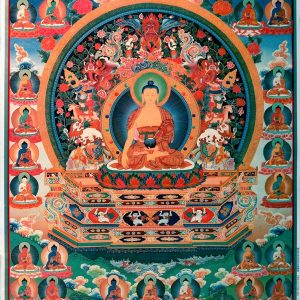
The practice of the 35 Confessional Buddhas is one of the best methods to purify our negative karma and can lead to attainments on the path towards enlightenment.
The practice of the 35 Confessional Buddhas is one of the most long lasting purification practices that has been propagated since the time of Buddha Shakyamuni. The practice itself was derived from the Mahayana Sutra of the Three Superior Heaps, which in Sanskrit is known as Triskandhadharmasutra.
This text was originally spoken by Buddha Shakyamuni himself and was taught within the Ratnakutasutra, an ancient collection of Mahayana Buddhist sutras. In a commentary by Nagarjuna, the origin of the practice can be traced to 35 Bodhisattva students of Buddha Shakyamuni, who were implicated in the death of a beer-seller’s son. Having remorse, they confessed their downfall to the Elder Upali, who was exemplary in upholding his monastic vows and commitments. They pleaded for him to relay their confession to Buddha Shakyamuni and to request a teaching to purify their wrongdoing. Buddha Shakyamuni saw that these 35 Bodhisattva students were actually innocent in the case but for the sake of future practitioners, he taught the Triskandhadharmasutra as a means to purify the downfalls of practitioners.
One of the most famous examples of those who practised the 35 Confessional Buddhas is Lama Tsongkhapa. He is well-known to have engaged in a purification retreat during which he performed 3.5 million prostrations. This was made up of 100,000 prostrations to each of the 35 Confessional Buddhas. In a pure vision he was advised by Manjushri to engage in this retreat in order to establish a direct perception of emptiness. In the process of his extraordinary and intensive retreat, he left the imprint of his sacred body on the floor of his retreat cave due to his prostrations. Consequently, as he came close to the completion of his retreat, he beheld pure visions of the 35 Confessional Buddhas and the glorious Buddha Maitreya along with the direct or non-conceptual perception of emptiness.
The Law of Cause and Effect
Although karma is considered by many to be the mainstay of the Buddha’s teachings, the Buddha himself did not actually invent the doctrine of karma. He taught karma, or the law of cause and effect, based on his own observations in a similar manner to how Isaac Newton discovered gravity by observing the effects that gravity had on an apple falling from a tree.
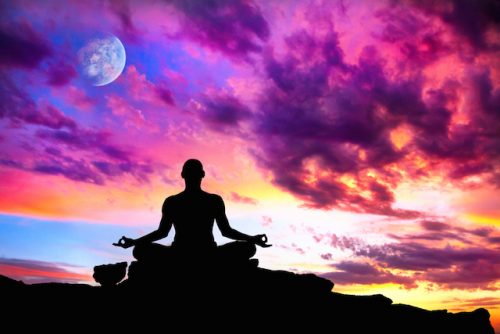
Contrary to what people think, Buddha Shakyamuni did not invent the doctrine of karma but came to the realisation that it exists and how it works. In order to help beings overcome the suffering caused by karma, Buddha Shakyamuni taught the Dharma which is the method to purify negative karma. One such powerful method of purification is the practice of the 35 Confessional Buddhas.
For most people, the effects of karma can be perceived and understood through ‘inferential logic’ or observations based on reason. A simple example of inferential logic is when we see a column of smoke in the horizon. From that, we can deduce that there is a fire although it may be too far away for us to see with our naked eyes. Likewise, when we see inequality in this world – how some people are born in sheer poverty while others are born into the lap of luxury – we can deduce that there are factors at work driving this result. That factor is karma. The different circumstances that people are born into are due to the ripening of different karmas from previous lives. If we look at this objectively, we will see that the reasoning of karma is a compelling one and can effectively explain why we go through different types of experiences.
Karma in ancient Sanskrit means the actions or deeds of our body, speech and mind. On the other hand, the effects of karma are called vipaka or the ripening or maturation of karma, that comes back to us through the results and effects that we experience. There are many factors behind every one of our actions that determines their consequences. The most important of these factors on the consequence of our actions is our intent. The intent or motivation behind our actions is a subject that is much discussed in Buddhist teachings. If understood, this is the very point that can turn our lives around. The intent also determines whether the action is going to be positive, negative or one that is to be added to our store of merits necessary for the attainment of enlightenment.
At this point, it is important to understand the distinction between karma and merit. Karma is ordinary negative or positive actions that have arisen from the self-cherishing mind and are motivated directly or indirectly towards one’s benefit. As a result, karma is finite and can eventually be exhausted especially through purification practices. On the other hand, merits are virtuous actions that are dedicated with a selfless intent and towards one’s enlightenment.
Therefore, the results of merit cannot be exhausted and will eventually lead one towards full enlightenment. Although merit cannot be exhausted it can be overwhelmed by the sheer amount of our negative karma, making it difficult for us to benefit from it. This again goes to show how important purification practices are to prevent our merits from being overwhelmed.
On the other hand, the law of cause and effect (karma-vipaka) has an inextricable link with our previous and future lives. In fact, the accumulation of karma in each life determines our next rebirth (known as throwing karma) and the circumstances of future lives (known as completing karma). Hence, we can reasonably interpret what our previous lives might have been like by looking at the circumstances of our current life and the interests we pursue. For example, a life of poverty is a direct result of miserliness and to have poor health in this life is due to the harming of other beings in previous lives. Hence, the results always resemble the causes.
Karma also has a strong effect on our minds and the way we operate. Unfortunately for us, negative karma multiplies over time due to our predominantly self-cherishing actions. Therefore, people are imbued with all manner of emotional and psychological afflictions such as aggression, greed, depression and so forth. This leads to more confusion and conflict that increases our sense of dissatisfaction and misery. The principal source of our pain and suffering actually stems from the mind and our outlook on life. If we reduce harmful mental factors (e.g., projections, expectations and mental afflictions), peace of mind, contentment and happiness will arise.
Confessional Practice
In Buddhism, the holding of vows is an important practice. There are three main sets of vows – the Pratimoksha vows of a layperson, monk or nun; the Bodhisattva vows; and the Tantric vows for those with higher tantric initiation. These vows coupled with commitments and refraining from committing unwholesome actions forms the basis of an effective practice that bears fruit leading to spiritual realisations.
Keeping our commitment to uphold our vows is an integral component of the practice. Therefore it is important to purify the negative karma and imprints that accrue from our transgressions by confessing them and promising not to repeat these downfalls again. In this way, we reduce or completely eliminate the strength of negative imprints from previous negative actions. The main component of purification is confession, which is to expose transgressions and lay them bare. Hence in Tibetan, confession is called shakpa or ‘laying it bare’. In Buddhist practice, keeping our transgressions a secret makes it difficult to purify, and the negative effects of the misdeed will continue. Hence, exposing our faults is what confession is all about; honesty and openness in all situations is the essence of Buddhist practice.
In order for the confession to truly purify the misdeed, it must be done in accordance with the Four Opponent Powers. The first of the Opponent Powers is that of regret. The power of regret is activated when we genuinely see the faults of our transgressions and realise that they will result in negative repercussions. When we do this we are filled with remorse. The second Opponent Power is that of reliance on an object worthy of refuge, in this case the 35 Confessional Buddhas. Each of these Buddhas is fully enlightened, and therefore any prayer, prostration, offering or confession that is offered to them will result in purification and the collection of merit.
The third Opponent Power is the determination not to repeat the downfall or misdeed. This follows the understanding of the faults of our downfall and that they lead to heavy negative repercussions. Hence, we make a firm resolution not to repeat the downfall. This leads to the fourth and final Opponent Power, which is that of the application of the remedy or counteracting measures to purify the karma. This is not blind penance for the wrongs that we have done but instead the remedies are performed with the understanding of the law of cause and effect, and with the purpose of counteracting the negative tendencies of the karma that is being purified.
The practice of prostrating or recitation of the Mahayana Sutra of the Three Superior Heaps contains the ‘remedy’ and ‘refuge’ components, and therefore if it is done with sincere regret and firm resolve not to repeat the transgression, it becomes very a potent counteracting measure to the negative karma that has been accumulated.
35 Confessional Buddhas
In the Tibetan edition of the Mahayana Sutra of the Three Superior Heaps, the term Dezhin Shegpa (Tathagata or ‘One thus gone’) was added as an honorific title before the names of each of all 35 Confessional Buddhas. This inclusion was made by Je Tsongkhapa after experiencing a vision of the 35 Confessional Buddhas without their heads. Upon praising them however, with the honorific ‘Dezhin Shegpa’ their heads miraculously appeared. Since then, a tradition was started by Je Tsongkhapa to recite the names preceded by the honorific title Dezhin Shegpa.
The practice of the 35 Confessional Buddhas as contained within the Mahayana Sutra of the Three Superior Heaps is a confessional practice. There are two forms of confession – ultimate and relative confession. The ultimate or greater confession is the meditation on the lack of inherent existence of all phenomena. The relative or lesser confession is the application of the four opponent powers combined with prostration and / or other practices while recognising the illusory nature of reality.
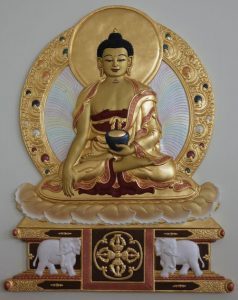
Buddha Shakyamuni
The following is the description of the 35 Confessional Buddhas:
1. The Tathagata, Buddha Shakyamuni
Buddha Shakyamuni’s name is followed by several honorific epithets such as, Foe Destroyer and Completely Perfected One. These names refer to the Buddha’s special qualities that have arisen due to his enlightened nature. Buddha Shakyamuni here refers to the historical Buddha who achieved full enlightenment under the Bodhi tree in Bodhgaya. He is golden in colour and sits in full meditation posture with his hands in the earth-touching gesture, or Bhumisparsha mudra. He purifies all negative karma accumulated over 10,000 eons.
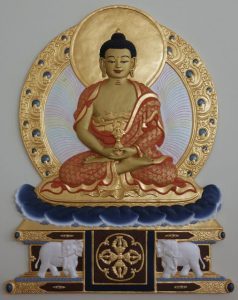
Buddha Vajrapramardi
2. The Tathagata, Complete Subduer With the Essence of Vajra (Vajrapramardi, Dorje Nyingpo Rabtu Jompa)
He is seated above Buddha Shakyamuni in the world called ‘Essence of Space’. He is blue in colour and he holds a golden vajra in his hands. ‘Vajra’ or adamantine refers to his primordial nature that is non-conceptual. ‘Essence’ in his sacred name refers to his excellent enlightened qualities, while him being a ‘Complete Subduer’ refers to his ability to destroy and purify emotional afflictions and 10,000 eons worth of negative actions.
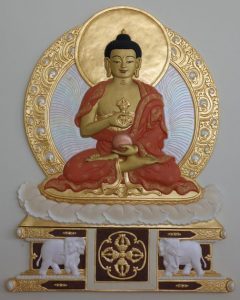
Buddha Ratnacis
3. The Tathagata, Jewel of Radiant Light (Ratnarcis, Rinchen O’tro)
He is seated to the East in front of Buddha Shakyamuni in the world called ‘Endowed with Jewels’. He is white in colour and holds both a vajra and the sun in his hands. ‘Jewel’ in his name refers to his excellent qualities which is pristine awareness, much like the clear light that dispels the darkness of ignorance. The radiant light refers to his ability to reach out to eliminate the ignorance of sentient beings. Therefore, he purifies the negative actions accumulated over 25,000 eons.
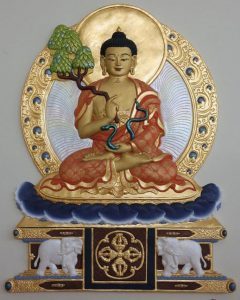
Buddha Nageshvararaja
4. The Tathagata, Powerful King of the Nagas (Nageshvararaja, Luwang Gyi Gyalpo)
He is seated to the South-east of Buddha Shakyamuni in the world called ‘Pervaded by Nagas’. He is blue in colour and holds in his hands a branch of a Naga tree and a blue serpent. ‘Naga’ in his name refers to his primordial awareness that is cooling and also likened to a naga in the way it destroys the grasping at inherent existence. He is a glorious king in the transcendent manner of a fully enlightened being who has eradicated all traces of fear in his mind stream. He purifies negative actions accumulated over eight eons.
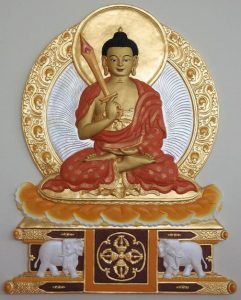
Buddha Virasena
5. The Tathagata, Leader of the Heroes (Virasena, Pawo De)
He is seated to the South of Buddha Shakyamuni in the world called ‘Pervaded by Heroes’. He is yellow in colour and holds in his hands, a Dharma text and a sword. The ‘Hero’ here refers to his primordial awareness, which is peerless, and the way he remains undefeated and victorious over all battles of the cycle of existence. ‘Leader’ in his name refers to the accumulations of excellence of a fully enlightened being. He purifies the negative karma of speech.
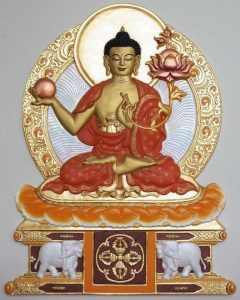
Buddha Viranandi
6. The Tathagata, Glorious Pleasure (Viranandi, Pawo Gye)
He is seated in the South-west region in the world called ‘Endowed with Pleasure’. He has an orange-coloured body and holds in his hands the sun and a red lotus. ‘Pleasure’ in his name refers to his great compassion to benefit sentient beings. He purifies negative karma of the mind.
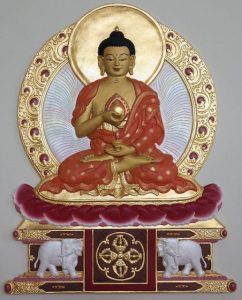
Buddha Ratnagni
7. The Tathagata, Jewel Fire (Ratnagni, Rinchen Me)
He is seated in the Western region in the world called ‘Pervaded by Light’. He is red in colour and holds in his hands a precious jewel and a ring of fire. ‘Jewel’ in his name refers to his pristine awareness that is free from discursive thoughts. His excellent qualities arises from meditative equipoise and are complete in the accumulation of insight and merit. ‘Fire’ in his name refers to his great ability to benefit sentient beings through his awareness and, with the great energy, burn away all mental afflictions. He purifies the extreme negative karma of causing schism in the sangha.
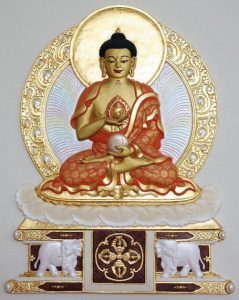
Buddha Ratnachandraprabha
8. The Tathagata, Jewel Moonlight (Ratnacandraprabha, Rinchen Da’od)
He is seated firmly in the North-western region called ‘Excellent Light’. He has a white body and holds in his hands a jewel and a moon. ‘Jewel’ in his name refers to his excellent state of primordial awareness, free of all negativities. ‘Moonlight’ refers to his awareness that is full, bright and cool. The light purifies the negative karma and afflictive emotions while lighting the path to enlightenment. He purifies negative karma that was accumulated over one single eon.
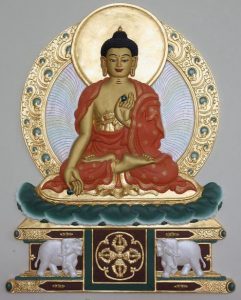
Buddha Amoghadarsi
9. The Tathagata, Meaningful to Behold (Amoghadarsi, Thongpa Donyo)
He is seated in the Northern region in a world called ‘Drumbeat’. He is green in colour and holds the two eyes of a fully enlightened being. He possesses unobscured pristine awareness and also the excellent quality of having the eyes of wisdom (and great compassion) to perceive the nature of reality and the karma of sentient beings. He purifies the heavy negative karma of criticising superior beings.
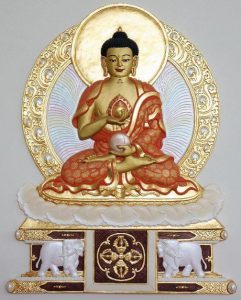
Buddha Ratnacandra
10. The Tathagata, Jewel Moon (Ratnacandra, Rinchen Dawa)
He is seated in the North-eastern region in the world called ‘Adorned with Light Rays’. He is pale-green in colour and holds in his hands a precious jewel and a moon. The ‘Jewel’ in his name refers to his excellent quality of pristine awareness, free of obscuration. The ‘Moon’ refers to his awareness and great compassion. He purifies the heavy negative karma of killing one’s mother.
11. The Tathagata, Stainless One (Vimala, Drima Mepa)
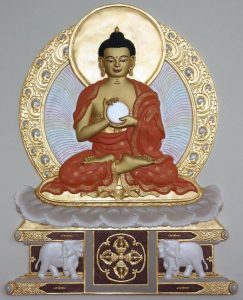
Buddha Vimala
He is seated directly below Buddha Shakyamuni in the world called ‘Pervaded by Dust’. He has an ashen-coloured body and he holds in his hands two stainless mirrors. The ‘Stainlessness’ in his name reflects his inner quality of pristine awareness that is without obscuration, and he purifies the karma of sentient beings so that they achieve the same ‘stainless’ state. He purifies the heavy negative karma of killing one’s father.
This concludes the first group of 10 Buddhas surrounding Buddha Shakyamuni. The subsequent 10 are visualised directly above the first group of Buddhas.
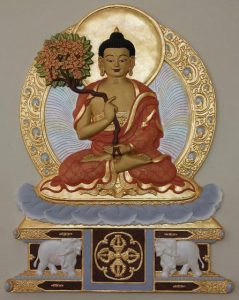
Buddha Suradatta
12. The Tathagata, Bestowed With Glory (Suradatta, Pa Jin)
He is firmly seated in the direction above Buddha Shakyamuni in the world called ‘Endowed With Glory’. He is white in colour, and he holds in his hands a branch of a tree that has leaves and fruits growing from it. ‘Glory’ in his name refers to his excellent quality of primordial awareness that is free of obscuration. He bestows upon sentient beings the complete accumulation of merit and insight along with happiness. He is a ‘bestower’ of transcendent pleasure and fulfillment of the wishes of all sentient beings. He purifies the heavy negative karma of killing an Arhat.
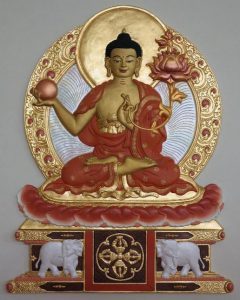
Buddha Brahma
13. The Tathagata, Pure One (Brahma, Tsangpa)
He is seated in the Eastern direction in the world ‘free from obscuration’. He is orange in colour and he holds in his hands a lotus and a sun. He is called ‘Pure’ as a reflection of his innate pristine awareness that is unobstructed. He purifies all sentient beings from the karma affecting death and rebirth, and also the heavy negative karma of wounding a fully enlightened Buddha.
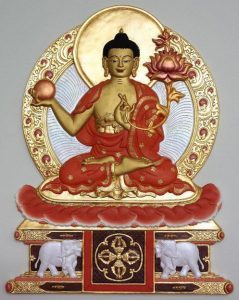
Buddha Brahmadatta
14. The Tathagata, Transforming With Purity (Brahmadatta, Shang Pey Jin)
He is seated firmly in the South-eastern direction in the world ‘Without Sorrow’. He is yellow in colour and holds in his hands a moon and a lotus. ‘Purity’ in his name refers to his pristine awareness that is without obstruction. Apart from purifying the karma of sentient beings, he is also able to bestow happiness to all. He wields the power to expiate the negative karma that was accumulated for over 10,000 eons.
15. The Tathagata, Water Deity (Varuna, Chu Lha)
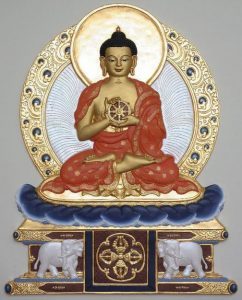
Buddha Varuna
He is seated in the Southern region in the world called ‘Stainless’. He is blue and has his hands in the gesture of bestowing the Dharma. ‘Water’ in his name refers to his pristine awareness, which is clear and unobstructed. The quality of water is also an epithet for his special ability to saturate the mindstream of sentient beings with the Dharma. The ‘Deity’ in his name represents his magical ability to create emanations in order to benefit sentient beings. He purifies the negative karma of raping nuns or Arhats.
16. The Tathagata, God of the Water Deities (Varunadeva, Chu Lha Yi Lha)
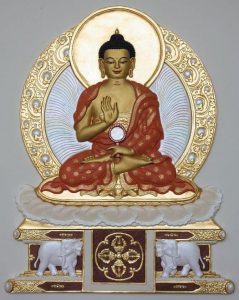
Buddha Varunadeva
He is seated firmly in the South-western region in the world called ‘Perfectly Clear’. He is white in colour and holds in his hands a circle or mandala of the water deity and a mirror. Just like the previous Buddha, ‘Water’ in his name refers to his pristine awareness and ‘Deity’ refers to his ability to emanate in order to benefit sentient beings. He clears the heavy negative karma of killing Bodhisattvas.
17. The Tathagata, Glorious Excellence (Sribhadra, Palzang)
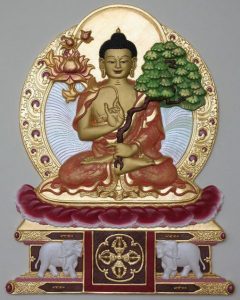
Buddha Sribhadra
He is seated firmly in the Western region in a world called ‘Blissful’. He is red in colour and holds a lotus and a branch of a wish-fulfilling tree. ‘Glorious’ in his name refers to his completely perfected mind for the sake of sentient beings. ‘Excellence’ refers to the pristine awareness. He purifies and delivers sentient beings to the state of full enlightenment.
18. The Tathagata, Glorious Sandalwood (Candanasri, Tsendan Pal)
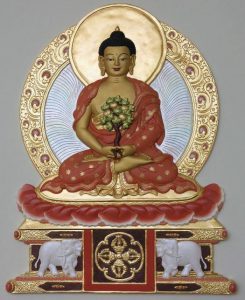
Buddha Candanasri
He is seated in the North-western region in a world called ‘Pervaded by Fragrance’. He is orange in colour and his hands hold a branch of a Sandalwood tree and a glorious fruit. ‘Sandalwood’ in his name refers to his excellent quality to ‘cool down’ and purify emotional afflictions such as ignorance and so forth. The scent of Sandalwood pervades the whole room when it is lit and likewise, he is able to imbue sentient beings with his supreme qualities of perfection. He purifies the negative karma of stealing from the Sangha community.
19. The Tathagata, Endless Splendour (Anantatejas, Zijid Thaye)
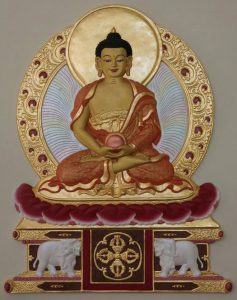
Buddha Anantatejas
He is seated in the Northern region in the world called ‘Endowed with Splendour’. He is red in colour and holds in his hands two suns and is surrounded by a retinue. ‘Splendour’ in his name refers to his pristine awareness and he is able to bring sentient beings to supreme clarity. ‘Endless’ refers to his boundless ability to liberate sentient beings and also refers to his innumerable excellent qualities. He clears the negative karma of destroying stupas.
20. The Tathagata, Glorious Light (Prabhasasri, O’pal)
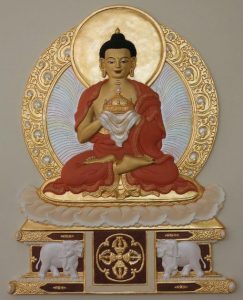
Buddha Prabhasasri
He is seated in the North-eastern region in the world called ‘Meaningful’. He is white in colour and holds a ring of white light. ‘Light’ in his name refers to his pristine awareness which is like the sun that dispels the darkness due to obscurations, paving the way for liberation and omniscience. ‘Glorious’ refers to his excellent and perfect qualities of a fully enlightened being. He negates the negative karma resulting from committing actions out of hatred.
21. The Tathagata, Glorious Without Sorrow (Asokasri, Nyangen Mepa Pal)
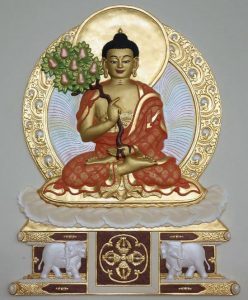
Buddha Asokasri
He is seated below the Stainless One in the world called ‘Unobstructed’. He is pale blue in colour and he holds in his hands a branch of the Asoka tree. ‘Without Sorrow’ in his name refers to his primordial awareness that has overcome cyclic existence and is able to liberate sentient beings. ‘Glorious’ refers to perfection in his excellent qualities. He cleanses negative karma borne out of attachment.
22. The Tathagata, Son Without Craving (Narayana, Sidme Kyibu)
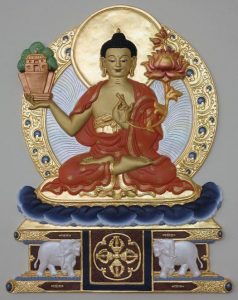
Buddha Narayana
He is seated firmly in the region above Buddha Shakyamuni in the world called ‘Free From Attachment’. He is blue in colour and his hands are in the gesture of Mount Meru while holding a lotus. ‘Without Craving’ in his name refers to his primordial awareness that is free from all negative afflictions and he liberates sentient beings from attachment to cyclic existence. ‘Son’ here refers to him being born from the awakened state of mind and also his quality of loving-kindness. He purifies the negative karma accumulated over 10,000 eons.
23. The Tathagata, Glorious Flower (Kusumasri, Metog Pal)
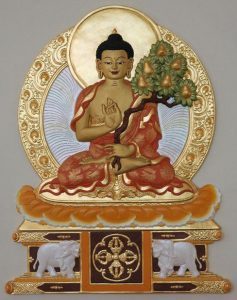
Buddha Kusumasri
He is seated in the Eastern region in the world called ‘Increasing Flowers’. He is yellow in colour and holds in his hands a yellow flower and a glorious fruit. ‘Flower’ in his name refers to his blossoming pristine awareness that is beautiful and which unfolds excellent qualities in sentient beings. ‘Glorious’ refers to his bestowing complete perfection in sentient beings. He purifies the negative karma accumulated over 100,000 eons.
24. The Tathagata, Clearly Knowing Through Enjoying Pure Radiance (Tathagatabrahamajyotivikriditabhijna, Dezhin Shegpa Tsangpe Ozer Nampar Rolpa Ngonpa Khyenpa)
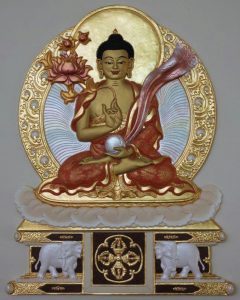
Buddha Tathagatabrahamajyotivikriditabhijna
He is seated in the South-eastern region in the world called ‘Pervaded by Purity’. He is white and holds in his hands a lotus and pool of light. The ‘Tathagata’ or ‘Dezhin Shegpa‘ epithet is specifically attributed to this Buddha although it is also attributed to the remaining Buddhas. ‘Purity’ in his name refers to his primordial awareness and ‘pure radiance’ refers to his various excellent qualities. ‘Enjoying’ in his name refers to his great ability to emanate in order to benefit sentient beings. He dissolves the negative karma accumulated over 1,000 eons.
25. The Tathagata, Clearly Knowing Through Enjoying Lotus Radiance
(Tathagatapadmajyotivikriditabhijna, Dezhin Shegpa Padme Ozer Nampar Rolpa Ngonpa Khyenpa)
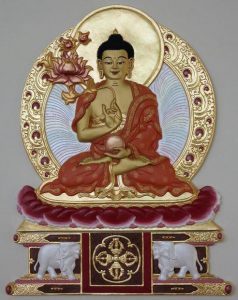
Buddha Tathagatapadmajyotivikriditabhijna
He is seated in the Southern region in the world called ‘Adorned with Lotuses’. He is red in colour and his hands are in the gesture of holding a lotus and a sun. ‘Lotus’ in his name refers to his primordial awareness that blossoms and inspires renunciation of worldly faults. ‘Clearly Knowing Through Enjoying Lotus Radiance’ refers to his various excellent qualities of an enlightened being. He purifies the negative karma accumulated over seven eons.
26. The Tathagata, Glorious Wealth (Dhanasri, Nor Pal)
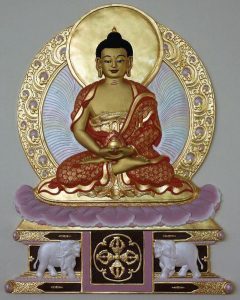
Buddha Dhanasri
He is seated in the South-western region in the world called ‘Endowed with Jewels’. He is bright red in colour and his hands hold two jewels. Jewels or wealth here refers to his pristine awareness, which has many excellent qualities that are increasing. He fulfills the wishes of sentient beings. ‘Glorious’ in his name refers to his ability to endow sentient beings with complete perfection. He purifies all negative karma arising from bad habituation.
27. The Tathagata, Glorious Mindfulness (Smrtisri, Drenpe Pal)
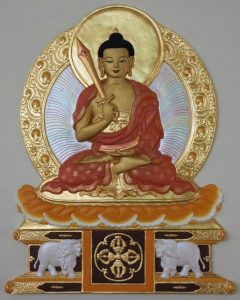
Buddha Smrtisri
He is firmly seated in the Western region in the world called ‘Perfectly Clear’. He is yellow in colour and his hands hold a sword and a Dharma text. ‘Mindfulness’ in his name refers to his primordial awareness that does not forget and having attained the ability to recall all his previous lives. ‘Glorious’ refers to his ability to bestow sentient beings with complete perfection. He purifies all negative karma of the body.
28. The Tathagata, Glorious Name of Great Renown (Suparikrititanamaghepasri, Tshenpal Zhintu Yongdrag)
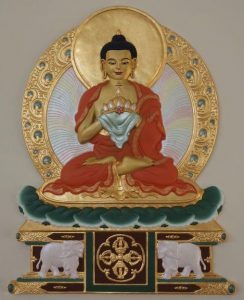
Buddha Suparikrititanamaghepasri
He is seated in the North-western region in the world called ‘Signless’. He is green in colour and his hands hold a crown of the Buddha above his head. ‘Name’ here refers to his primordial awareness that cognises reality; that is, phenomenon lacks inherent existence. ‘Great Renown’ refers to transcendent fame that pervades the three-realms of existence (Form, Formless and Desire realms). He purifies the negative karma of displeasing the Buddhas.
29. The Tathagata, King of the Victory Banner (Indraketudhvajaraja, Wangpe Togyi Gyeltsen Gyi Gyalpo)
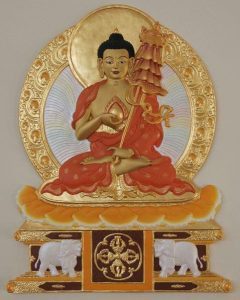
Buddha Indraketudhvajaraja
He is seated firmly in the Northern region in the world called ‘Clear Sense Powers’. He is yellow in colour and his hands hold a victory banner along with its precious crown pinnacle. He is also known to be the Pinnacle of Sensory Powers, which refers to his primordial awareness which perceives reality. This is the highest wisdom which directly perceives emptiness and therefore, it is placed as the pinnacle. ‘Victory Banner’ proclaims his victory over cyclic existence and ‘king’ refers to his enlightened nature. He purifies the negative karma of actions that were committed out of jealousy.
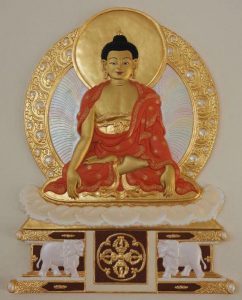
Buddha Suvikranta
30. The Tathagata, Glorious One Complete Subduer (Suvikranta, Shintu Nampar Nonpyi Pal)
He is seated firmly in the North-eastern region in the world called ‘Enjoyment’. He is white in colour and one of his hands is in the earth-touching gesture just like Buddha Shakyamuni. He is a ‘subduer’ of all emotional afflictions and malevolent forces. He neutralises the negative karma of ordering others to commit negative actions.
31. The Tathagata, Great Victor in Battle (Yuddhajaya, Gyule Shintu Nampar Gyalwa)
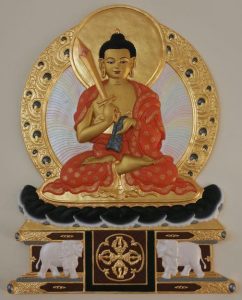
Buddha Yuddhajaya
He is firmly seated in the region below and in the world called ‘Without Delusion’. He is black and his hands are holding a sword and a shield. He is known by his name ‘Great Victor in Battle’ because he is able to defeat the inner enemies of afflictive emotions and negative actions of sentient beings. He is victorious over cyclic existence and thus able to lead all sentient beings to liberation. He purifies the negative karma of actions committed out of pride.
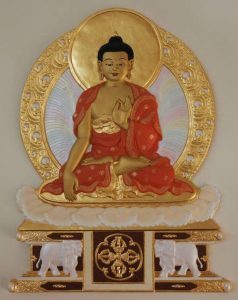
Buddha Vikrantagamsri
32. The Tathagata, Glorious One Complete Subduer Passed Beyond (Vikrantagamsri, Nampar Nonpe Shegpai Pal)
He is seated in the Eastern region of Buddha Shakyamuni in the world called ‘the Glorious’. He is white in colour and his hands are in the earth-touching gesture and granting fearlessness. He is known as a subduer who has vanquished all inner enemies of emotional afflictions and contaminated actions. Meanwhile, he is called ‘Glorious’ because of his ability to lead sentient beings to complete perfection. He purifies the negative karma created from slandering.
33. The Tathagata, Glorious Array Illuminating All (Samantavabhasavyuhasri, Kunney Nangwa Kodpai Pal)
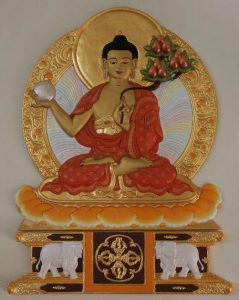
Buddha Samantavabhasavyuhasri
He is seated firmly in the Southern direction in the world called ‘Adorned with Light’. He is yellow in colour and he holds a sun and the stem of a precious jewel. ‘Illuminating All’ in his name refers to his pristine awareness that dispels ignorance of all sentient beings. He is called ‘Glorious’ because of his ability to lead sentient beings to complete perfection. He purifies the negative karma of rejoicing in evil deeds.
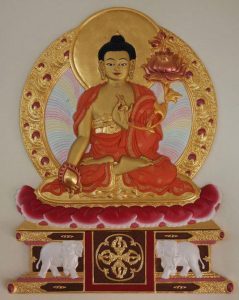
Buddha Ratnapadmavikrami
34. The Tathagata, Jewel Lotus Great Subduer (Ratnapadmavikrami, Rinchen Padmai Nampar Nonpa)
He is seated firmly in the Western direction in the world called ‘The Glorious’. He is red in colour and his hands hold a jewel and a lotus. ‘Jewel’ represents his excellent qualities of a fully enlightened being. The lotus represents the unstained nature of his mind. He is the great subduer of afflictive emotions and negative actions of sentient beings. He purifies the heavy negative karma of abandoning the Dharma.
35. The Tathagata, King of Mount Meru (Ratnapadmasupratisthitasailendraja, Dezhin Shegpa Dracompa Yangdagpa Dzogpai Sangye Rinpoche Dang Padma-la Rabtu Shugpa Riwang Gyi Gyalpo)
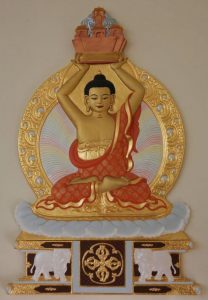
Buddha Ratnapadmasupratisthitasailendraja
He is seated in the Northern region in the world ‘Precious Jewels’. He is sky-blue in colour and his hands support Mount Meru. He is also seated on a throne that is embellished with a lotus, moon, lions and precious jewels. The Jewel and the lotus refer to his throne and those of other Buddhas. This jewel also refers to his primordial awareness and his possessing excellent qualities of an awakened being. ‘Mount Meru’ in his name refers to his unshakeable quality like that of the king of mountains. He purifies the negative karma of breaking one’s commitments.
Visualisation
While there are several ways in which to engage in the visualisation of the 35 Confessional Buddhas, they are all centred around Buddha Shakyamuni as the main figure. The following visualisation is taught by Lama Zopa Rinpoche.
You begin by visualising Buddha Shakyamuni slightly above yourself as the central figure. He is seated crossed-legged in an adamantine posture, on an elephant-supported pearl-white throne. Visualise Buddha Shakyamuni wearing the saffron robes of a fully ordained monk. His right hand is touching the earth and his left hand is cradling a begging bowl filled with wisdom nectar. From his heart, rays of light emanate out, 10 upwards and 10 downwards, seven to the left and seven more to the right. At the end of each ray of light emanates a pearl-white throne that is supported by elephants
The white pearl symbolises complete purification of our negative actions. On the other hand, the elephant that supports the throne is considered the strongest of animals and also symbolises great purification of negativities. On each throne sits a Buddha with their respective hand gestures and from each sacred Buddha, radiant light nectar shines forth and purifies your body, speech and mind from various negative karmas in the same manner as light dispels darkness. After visualising the 35 Confessional Buddhas in this manner, prostrate three times while reciting the following mantra:
OM NAMO MANJUSHRIYE
NAMO SUSRIYE
NAMO UTTAMASRIYE SVAHA
This mantra will greatly increase the benefits of your prostrations. Then, you can begin reciting the Mahayana Sutra of the Three Superior Heaps while continuing to prostrate. If you have not memorised the entire text, you may read through the text once and then begin prostrating while repeating the names of the 35 Confessional Buddhas. Upon completion of the prostrations, you can recite the entire text once again.
This purification of negative karma is especially efficacious if it is done early in the morning and just before going to sleep at night. It is the most effective way of making this life meaningful by engaging in this supreme purification. With this practice, one can purify tremendous amounts of negative karma without experiencing their results, or reducing the impact of the results and shore up tremendous amounts of merits to quickly achieve realisation. Therefore, the value of such a practice is beyond the most precious items in this world.
The Mahayana Sutra of the Three Superior Heaps
One can combine the following recitation with that of Refuge, Generating Bodhichitta, Guru Yoga of Lama Tsongkhapa and the tea offering verses and mantra to solicit the great Dharma Protector Dorje Shugden and the recitation of General Dedication at the end.
The 35 Confessional Buddha Prayer Text
Homage to the Bodhisattva’s Confession of Moral Downfalls.
I, whose name is [say your name at this point], at all times go for refuge to the Guru, go for refuge to the Buddha, go for refuge to the Dharma, go for refuge to the Sangha.The Vajra family of Akshobhya (blue in colour)
1. To the Teacher, Blessed One, Tathagata, Foe Destroyer, Completely Perfected Buddha, Glorious Conqueror Shakyamuni, I prostrate.
2. To the Tathagata, Complete Subduer with the Essence of Vajra, I prostrate.
3. To the Tathagata, Jewel of Radiant Light, I prostrate.
4. To the Tathagata, Powerful King of the Nagas, I prostrate.
5. To the Tathagata, Leader of the Heroes, I prostrate.
6. To the Tathagata, Glorious Pleasure, I prostrate.
7. To the Tathagata, Jewel Fire, I prostrateThe Tathagata family of Vairochana (white in colour)
8. To the Tathagata, Jewel Moonlight, I prostrate.
9. To the Tathagata, Meaningful to Behold, I prostrate.
10. To the Tathagata, Jewel Moon, I prostrate.
11. To the Tathagata, Stainless One, I prostrate.
12. To the Tathagata, Bestowed with Glory, I prostrate.
13. To the Tathagata, Pure One, I prostrate.
14. To the Tathagata, Transforming with Purity, I prostrate.The Ratna family of Ratnasambhava (yellow in colour)
15. To the Tathagata, Water Deity, I prostrate.
16. To the Tathagata, God of the Water Deities, I prostrate.
17. To the Tathagata, Glorious Excellence, I prostrate.
18. To the Tathagata, Glorious Sandalwood, I prostrate.
19. To the Tathagata, Endless Splendour, I prostrate.
20. To the Tathagata, Glorious Light, I prostrate.
21. To the Tathagata, Glorious without Sorrow, I prostrate.The Lotus family of Amitabha (red in colour)
22. To the Tathagata, Son without Craving, I prostrate.
23. To the Tathagata, Glorious Flower, I prostrate.
24. To the Tathagata, Clearly Knowing through Enjoying Pure Radiance, I prostrate.
25. To the Tathagata, Clearly Knowing through Enjoying Lotus Radiance, I prostrate.
26. To the Tathagata, Glorious Wealth, I prostrate.
27. To the Tathagata, Glorious Mindfulness, I prostrate.
28. To the Tathagata, Glorious Name of Great Renown, I prostrate.The Karma family of Amoghasiddhi (green in colour)
29. To the Tathagata, King of the Victory Banner, Head of the Powerful Ones, I prostrate.
30. To the Tathagata, Glorious One Complete Subduer, I prostrate.
31. To the Tathagata, Great Victor in Battle, I prostrate.
32. To the Tathagata, Glorious One Complete Subduer Passed Beyond, I prostrate.
33. To the Tathagata, Glorious Array Illuminating All, I prostrate.
34. To the Tathagata, Jewel Lotus Great Subduer, I prostrate.
35. To the Tathagata, Foe Destroyer, Completely Perfected Buddha, King of Mount Meru seated firmly on a jewel and a lotus, I prostrate.O All you Tathagatas and all the others, however many Tathagatas, Foe Destroyers, Completely Perfect Buddhas, Blessed Ones there are dwelling and abiding in all the worldly realms of the ten directions, all you Buddhas, the Blessed Ones, please listen to me.
In this life and in all my lives since beginningless time, in all my places of rebirth whilst wandering in Samsara, I have done negative actions, have ordered them to be done, and have rejoiced in their being done. I have stolen the property of the bases of offering, the property of the Sangha, and the property of the Sanghas of the ten directions, have ordered it to be stolen, and have rejoiced in it being stolen. I have committed the five unbounded heinous actions, have ordered them to be committed, and have rejoiced in their being committed. I have completely engaged in the paths of the ten non-virtuous actions, have ordered others to engage in them, and have rejoiced in their engaging in them.
Being obstructed by such karmic obstructions, I shall become a hell being, or I shall be born as an animal, or I shall go to the land of the hungry ghosts, or I shall be born as a barbarian in an irreligious country, or I shall be born as a long life god, or I shall come to have incomplete senses, or I shall come to have wrong views, or I shall have no opportunity to please a Buddha.
All such karmic obstructions I declare in the presence of the Buddhas, the Blessed Ones, who have become valid, who see with their wisdom. I confess without concealing or hiding anything, and from now on I shall avoid and refrain from such actions.
All you Buddhas, the Blessed Ones, please listen to me.
In this life and in all my previous lives since beginningless time, in all my places of rebirth whilst wandering in Samsara, whatever root of virtue there is in my giving to others, even in my giving a morsel of food to one born as an animal;
Whatever root of virtue there is in my maintaining moral discipline;
Whatever root of virtue there is in my actions conducive to great liberation;
Whatever root of virtue there is in my acting to fully ripen sentient beings;
Whatever root of virtue there is in my generating a supreme mind of Enlightenment;And whatever root of virtue there is in my unsurpassed exalted wisdom; all of these assembled, gathered and collected together, by fully dedicating them to the unsurpassed, to that which there is no higher, to that which is even higher than the high, to that which surpasses the unsurpassed,
I fully dedicate to the unsurpassed, perfect, complete enlightenment.
Just as the Buddhas, the Blessed Ones of the past, have dedicated fully, just as the Buddhas, the Blessed Ones who are yet to come, will dedicate fully, and just as the Buddhas, the Blessed Ones who are living now, dedicate fully, so too do I dedicate fully.I confess individually all negative actions. I rejoice in all merit. I beseech and request all the Buddhas.
May I attain the holy, supreme, unsurpassed, exalted wisdom.
Whoever are the Conquerors, the supreme beings living now, those of the past, and likewise those who are yet to come, with a boundless ocean of praise for all your good qualities, with my palms pressed together I go close to you for refuge.This concludes the Mahayana Sutra entitled “Sutra of the Three Superior Heaps”.
Conclusion
The practice of the 35 Confessional Buddhas is one of the most popular and perennial forms of purification practices. It is a practice popularised by great spiritual figures like Lama Tsongkhapa, who engaged in an extensive prostration retreat of the 35 Confessional Buddhas in order to purify and gain deeper insight into the teachings. The practice of the 35 Confessional Buddhas is considered one of the most potent forms of purification available for non-tantric practitioners.
In order for the practice of the 35 Confessional Buddhas to be effective, it has to be done with the Four Opponent Powers strongly along with the accompanying visualisation. When it is done with the Opponent Powers, you are not just purifying the symptomatic problem of a few transgressions but you are purifying the root of the problem itself, which is the self-cherishing mind. It is the self-cherishing mind that fuels our negative afflictions. Hence, the 35 Confessional Buddhas is a very powerful practice to lessen the effects of harmful mental afflictions like ignorance, hatred and desire and thus allowing spiritual attainments to surface.
Hence, 100,000 prostrations to the 35 Confessional Buddhas is one of the preliminary practices (ngondro) in preparation to receive highest tantric initiations. This is to purify negative karma as much as possible while accumulating as much merit so that when one is qualified to receive highest tantric initiation such as Vajrayogini, attainments arise swiftly.





Dear David,
Thank you for reposting Rinpoche’s explanations of the benefits of the 35 Buddhas. I came across this practice through different sources.
What I personally found very useful in this version, is that the specifics of each Buddha’s name, which karma they purify is given in detail!
Even if their effects (or awareness they bestow upong sentient beings ) is cooling in nature.
Thank you so much!
Physically being unable to do prostrations, I often recite the names. Sometimes just one Buddha’s name many times to try to see what effect it produced.
I was amazed by the experience. Sometimes i noticed emotions being purified. Sometimes other effects.
To people who read this, you can try it for yourself , it has surprising and beneficial effects.
I do have two questions:
1) Any idea where I can find the actual text of ‘ the Mahayana Sutra of the Three Superior Heaps ‘ ?
I would love to read it in the Buddha’s own words. Read was he has to ay about the benefits of each name, supposing that is in the original sutra.
2) Do you know of any other source(s) that speak of benefits of reciting any particular Buddha or Bodhisattva’s name?
I read Lama Zopa Rinpoche often advised students who were facing illness or obstacles to recite a specific Buddha’s name. But never found any textual sources.
Kind regards
Steven
Hi Steven,
1) The entire text is translated as the recitation text of the 35 Confessional Buddhas. I have written this article on the basis of a translation of Nagarjuna’s commentary to the 35 Confessional Buddhas.
2) Most of what I know about the benefits of a particular Buddha is derived from Rinpoche’s explanation. If you have a particular Buddha you want to know the scriptural basis of his benefits, just let me know.
And i forgot to ask,
Some lamas advise to add recital and prostrations to the Medicine Buddhas (to not fall into lower rebirths) to the confessional practice of the 35 Medicine Buddhas.
Any idea where i could find an explanation of each Medicine Buddha’s specific action or benefit?
Hi Steven again,
With regards to the Medicine Buddhas, I have actually written an article based on Rinpoche’s explanation sometime ago and I quickly blogged it while it was fresh in my mind. Therefore, I hope it retain most of what rinpoche had explained in relations to the benefits of Medicine Buddhs. Here is the blog post – http://www.davidlai.me/2010/11/06/bhaisajyaguru-the-medicine-guru/